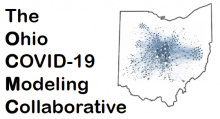A local team has developed predictive models that are helping policymakers and Northeast Ohioans make informed decisions about the COVID-19 pandemic. Publicly available since Fall, 2020, these sophisticated computational models are the product of an ongoing collaboration between the CWRU Center for Community Health Integration (CHI Center), the CWRU Department of Mathematics, Applied Mathematics and Statistics, and the University of Akron.
Working together as the Ohio COVID-19 Modeling Collaborative, CHI Center faculty member Johnie Rose, adjunct faculty Daniela Calvetti and Erkki Somersalo, and the University of Akron’s Alex Hoover have developed models that predict the virus’ infectivity, incidence, and ratio of symptomatic to asymptomatic cases in local counties.
Mathematical models have played a crucial role during the pandemic, providing a better understanding of the virus, predicting hospitalizations, and looking at the implications of potential policies.
There was an unmet need, however, for a county-level epidemiological model that predicted case volume based on local data and the realities of life in the COVID-19 era.
With that in mind, Calvetti, Hoover, Rose, and Somersalo adapted an epidemiological approach to create a new COVID-19 model that has proven highly accurate. It takes into account such factors as differences in behavior between symptomatic and asymptomatic people infected with the virus that causes COVID-19, the role of asymptomatic infection in disease transmission, individuals’ travel between communities, and geographic (rural vs urban) differences.
The collaborators began providing new COVID-19 models for the 6-county Cleveland metropolitan area over the summer. Demand quickly grew, and they now produce weekly models for 31 counties in Ohio’s Zone 1.
The model can be adapted to other county-level networks as well.
According to Dr. Rose, each of the collaborators brings important strengths to the project. Daniela Calvetti and Erkki Somersalo, well known for their work on large-scale scientific computing and inverse problems, “literally wrote the book on predictive modeling,” said Rose. Alex Hoover’s expertise in applied mathematics includes geospatial networks and parameter estimates, while Rose, a preventive medicine physician-researcher, brings clinical public health, informatics, and community/population health data perspectives.
Their work has been published in Frontiers in Physics and is posted at https://arxiv.org/abs/2005.04365 .


